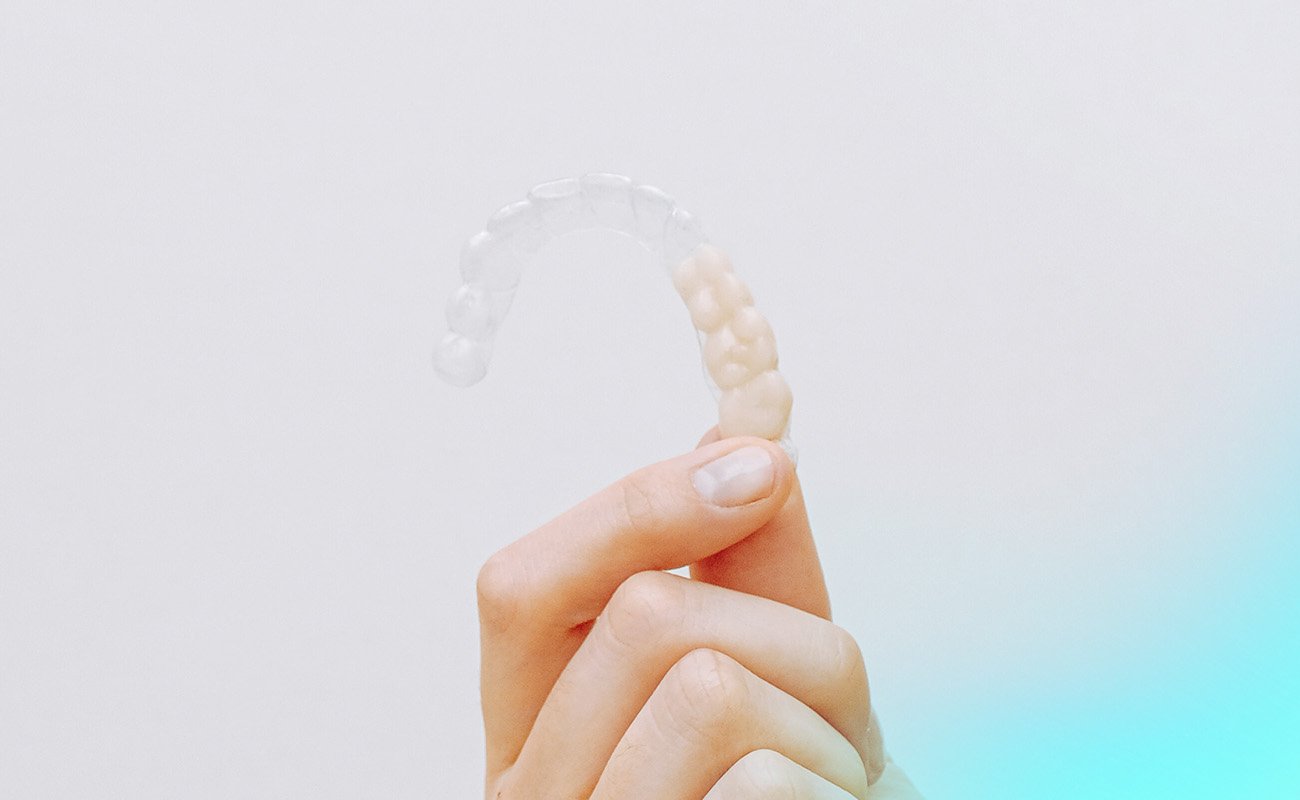If you are considering clear aligners to straighten your teeth, you are not alone. A lot of people are choosing this option because it is a more discreet way to achieve the smile they want. Learn about the benefits, processes, and results of this popular orthodontic treatment. Read our article “Clear Aligners – Before and After” and say hello to a confident smile.
How do Aligners Work?
Aligners are a great option to straighten your teeth without having to use metal brackets. They provide an easy and effective way of realigning your teeth through frequent, small adjustments. Aligners are designed to be comfortable, discreet, and transparent. They look like a part of your natural smile. They are comfortable and easy to wear, with a smooth surface that avoids irritation or injury to the delicate tissue of the mouth.
Aligners utilize a series of custom-fabricated, form-fitting trays to incrementally adjust the positioning of teeth towards a desired alignment. These trays are constructed from a durable, clear plastic material, chosen for their blend of strength, flexibility, and near invisibility when worn. The process begins with a detailed mapping of the individual’s dental structure, often using advanced 3D imaging techniques, to ensure each aligner is tailored to the specific contours of their teeth and gums.
Each aligner in the series is worn for approximately two weeks, during which it applies gentle pressure to the teeth, guiding them into their new positions. After this period, the aligner is replaced with the next in the sequence, continuing the gradual realignment process. For optimal effectiveness, it is recommended that aligners be worn for 20 to 22 hours per day. This allows for removal during meals and dental hygiene routines, ensuring ease of use and maintenance without compromising the treatment’s progress. The duration of treatment with clear aligners can vary depending on the individual’s needs, ranging from a few months to a couple of years.
See our article: Invisible Braces – How They Work?
What Malocclusions Do Aligners Treat?

Open Bite
An open bite is a dental condition where the upper and lower teeth do not touch when the mouth is closed, creating a noticeable gap or space between them. This can affect both the front (anterior open bite) and back (posterior open bite) teeth. Causes of an open bite range from genetic predispositions to habits such as thumb sucking or prolonged use of a pacifier during childhood, and even issues related to the jaw’s skeletal structure.
An open bite can significantly impact oral health by making chewing less efficient and possibly leading to speech difficulties. It can also increase the risk of other dental problems, such as tooth wear and TMJ disorders, due to the uneven distribution of biting forces.
Treatment options for an open bite often involve orthodontic interventions such as braces or clear aligners, and in some cases, surgery may be recommended to address skeletal discrepancies.
Overbite
An overbite is characterized by the upper front teeth protruding significantly over the lower front teeth, often noticeable when the bite is closed. It is one of the most common types of malocclusion. An overbite can stem from a variety of causes, including genetic jaw structure, the early loss of baby or adult teeth, and habits such as thumb sucking or excessive nail biting, which can affect jaw development.
An overbite can lead to a range of oral health issues, from difficulty in properly chewing food to speech impediments, and even increased wear and tear on the tooth enamel, potentially leading to tooth decay and gum disease. It can also contribute to jaw pain and discomfort due to the misalignment of the jaw. Treatment options vary based on the severity of the overbite and can range from orthodontic solutions like braces or clear aligners to more complex procedures, including orthognathic surgery for severe cases.
See our article: Overbite Face Shape.
Crossbite
A crossbite is a dental condition where one or more of the upper teeth bite inside the lower teeth, which can occur at the front (anterior crossbite) or the sides (posterior crossbite) of the mouth. This misalignment can result from a mix of genetic and environmental factors, such as delayed loss of baby teeth, irregular permanent teeth eruption, or habits like thumb-sucking that affect jaw development.
If left untreated, this condition can cause physical suffering such as jaw muscle spasms and headaches. It can also affect a person’s speech and chewing abilities. Treatment typically involves orthodontic interventions, such as braces, clear aligners, or palate expanders, aimed at moving the teeth into their correct positions and, in some cases, reshaping the jaw.
Spacing
Spacing, often referred to as diastema when it specifically occurs between the two upper front teeth, is a dental condition characterized by noticeable gaps or spaces between teeth. These spaces can appear anywhere in the mouth and vary in size, sometimes contributing to aesthetic concerns or affecting one’s self-confidence.
The causes of spacing are diverse, including factors such as the size of the teeth being too small relative to the jawbone, missing teeth, or habits that exert pressure on the teeth, like thumb sucking. In some cases, it’s simply a genetic trait. While spacing might not directly impact oral health, it can lead to issues such as food particles getting trapped in the gaps, which increases the risk of plaque buildup and gum disease.
Treatment options for spacing depend on the extent of the condition and the patient’s preferences, ranging from cosmetic solutions like dental bonding or veneers to orthodontic approaches using braces or clear aligners to close the gaps.
Worth Knowing
Although it is not possible to prevent all cases of diastema if the cause is due to gum disease or bad habits you can improve the condition by practicing good oral hygiene such as brushing your teeth twice daily, flossing, having regular dental examinations, and avoiding thumb sucking in children.
Crowding
Crowding occurs when there is insufficient space in the jaw to accommodate all of the teeth, leading to overlapping, twisting, or displacement. This condition can affect both the appearance and functionality of one’s smile, with teeth often appearing crooked or misaligned. Crowding can result from a variety of factors, including genetic predisposition to smaller jaw size or larger teeth, premature loss of baby teeth, or improper eruption of adult teeth.
Crowded teeth can complicate oral hygiene, making it challenging to effectively brush and floss, which in turn increases the risk of dental issues such as cavities and gum disease. Treatment typically involves orthodontic interventions, such as braces or clear aligners, aimed at realigning the teeth and creating adequate space. In some cases, extractions may be necessary to provide the needed room for proper alignment.
See our article: How to Fix a Snaggletooth?
How Long Does Treatment with Clear Aligners Last?
Wearing aligners typically requires orthodontic treatment for anywhere from six months for mild cases to eighteen months for more complex issues, although the exact amount of time varies depending on the individual’s specific needs.
As a guideline, adults should expect to wear their aligners between 20 and 22 hours per day to achieve optimal results promptly. Although the length of treatment can vary greatly, most patients begin to see noticeable improvements after just a few months of wearing aligners.
See our article: Quickest Way to Straighten Teeth.
Clear Aligners Before and After
Clear aligners have been highly effective in providing quick and discreet answers to smile confidence issues and are also an affordable and efficient route to straighten teeth. Not only are issues such as overcrowding, gaps, or misalignment corrected but there is often an accompanying boost in self-confidence in looking better and feeling more confident in less obvious ways. It’s amazing to witness the transformation that clear aligners can produce. Before and after images of patients undergoing clear aligner treatment show remarkable improvements in their overall alignment.
See some reviews of the best clear aligners available here:
Byte – The top pick, this aligner is affordable and comes with a HyperBite and teeth whitening kit. This product also has a lifetime guarantee. See our review of Byte aligners.

Byte
An affordable option with refundable impression kits, free HyperByte, and a Byte for Life guarantee.
Check out Byte AlignersCandid – The most similar to Invisalign aligners with hybrid in-office care this product has great reviews from its customers. See our review of CandidPro aligners.

Candid
A hybrid of in-office and at-home treatment that provides 1-on-1 orthodontist support.
Check out Candid AlignersALIGNERCO – The cheapest invisible aligner on offer with a zero deposit option on a monthly payment plan. They offer 24/7 live chat support should you have any questions about your aligner or treatment. See our review of AlignerCo aligners.

AlignerCo
The cheapest at-home aligners, with monthly plans, no down payment, and considerable discounts.
Check out AlignerCo AlignersFrequently Asked Questions
Are Aligners Worth it?
Designed to help straighten teeth without the necessity of extra appointments, cumbersome wires, or brackets, aligners are also virtually invisible when worn and can be removed for eating or cleaning, allowing you to maintain your regular oral hygiene routine with ease.
An article on the Bupa Healthcare website states that clear aligners are more comfortable and flexible than traditional braces. They are also removable so you will find it much easier to eat and brush your teeth normally during treatment.
Aligners are worth using if you want straighter teeth with lower maintenance, fewer appointments and a more normal appearance during treatment.
How Long Do You Have to Wear Aligners to See Results?
The length of time they need to be worn depends on your circumstances but generally, it is between 6-18 months. During treatment, you will need to wear your retainers for 20-22 hours each day to get the desired results.
Sources:
Khosravi R, et al. Management of overbite with the Invisalign appliance. Am J Orthod Dentofacial Orthop 2017;151:691e699.e2. Available online at: https://pubmed.ncbi.nlm.nih.gov/28364892/
Alansari, R. A., Faydhi, D. A., Ashour, B. S., Alsaggaf, D. H., Shuman, M. T., Ghoneim, S. H., Linjawi, A. I., Marghalani, H. Y., Dause, R. R., Adult Perceptions of Different Orthodontic Appliances, PubMed Central. 2019; DOI: 10.2147/PPA.S234449. Available online at: https://www.ncbi.nlm.nih.gov/pmc/articles/PMC6916694/
Jaber, S. T., Hajeer, M. Y., Sultan, K., Treatment Effectiveness of Clear Aligners in Correcting Complicated and Severe Malocclusion Cases Compared to Fixed Orthodontic Appliances: A Systematic Review, Cureus. 2023 Apr; 15(4): e38311. DOI: 10.7759/cureus.38311. Available online at: https://www.ncbi.nlm.nih.gov/pmc/articles/PMC10148732/

